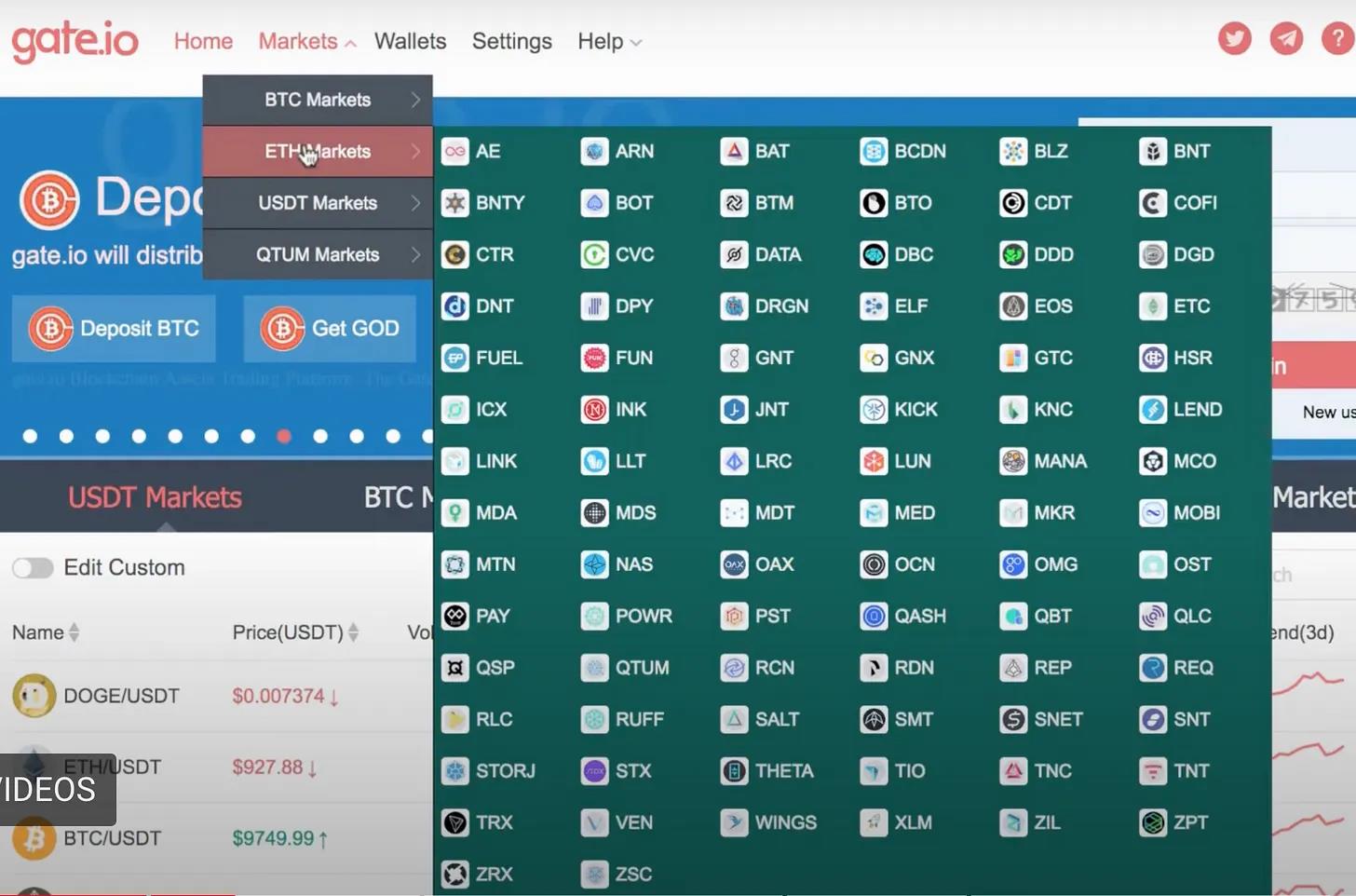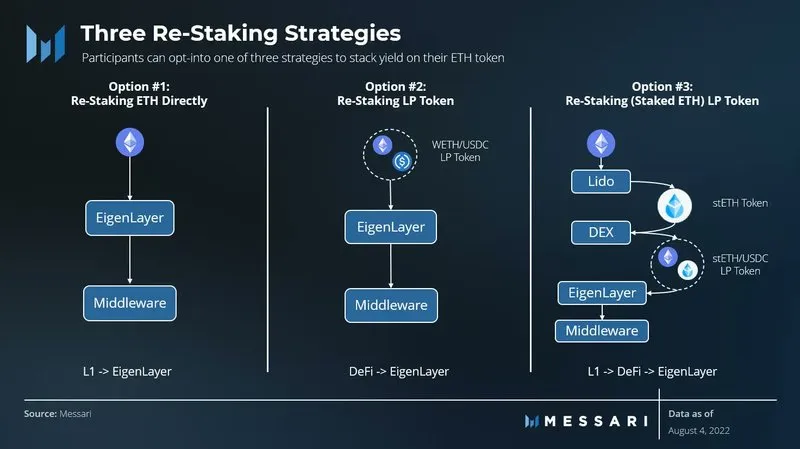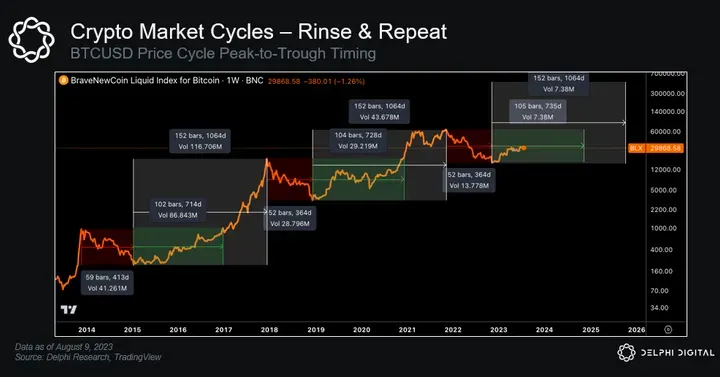Author: IGNAS | DEFI RESEARCH
Translation: Deep Tide TechFlow
It is widely believed that cryptocurrencies need to go through three cycles of encryption before they can truly achieve this goal: the first cycle is to acquire knowledge and learn important lessons about how cryptocurrencies operate, the second cycle is to earn some profits and feel comfortable, and the third cycle is to achieve financial freedom.
For me, this is the second bear market, and the third bull market is coming soon. I’m ready.
- Base completely binds shared income with Optimism to open up a new paradigm in the industry.
- friend.tech’s Void Trading Toxic Innovation that Manipulates the Price Timeline
- Base completely binds Optimism with shared income to open up a new paradigm in the industry.

I feel like I’ve been through the current stage of the cryptocurrency market before. Because I have indeed experienced it, specifically the 2019-2020 market cycle.
But I’m not just talking about the downward trend in prices. I’m referring to the overall market sentiment: government regulatory crackdowns, the general public’s indifference to cryptocurrencies or accusations of scams, and the PvP mode of profiting from the alternation between different tokens.
If you joined the cryptocurrency market in the last bear market or even earlier, you may have the same feeling. This sense of familiarity is a huge advantage because your past experiences in the crypto field lay the foundation for the upcoming bull market.
Every bull market and bear market have some differences, but the overall situation is similar.
This article will explore how past experiences have taught us to recognize the beginning of the next bull market based on my experience.
A Familiar Market
The First Bull Market and Crash
A familiar feeling is a feeling that makes you feel like you have experienced the current situation before. Although this feeling usually only lasts for a few seconds, the current cryptocurrency familiar phase has lasted for several years.
I joined the cryptocurrency market in late 2017, having been exposed to articles from the BBC introducing Bitcoin constantly setting new historical highs. I felt FOMO for the first time.
I bought some Bitcoin, and the price quickly doubled. I felt very excited, thinking that I was smart and entered a new financial paradigm early. This excitement quickly turned into confidence, and I believed that if I invested in newer and cheaper tokens, I could make more money.
I searched on Google for exchanges because the exchange I first used (Bitstamp) didn’t have many junk coins, and then somehow I found Gate.io CEX. I liked their old user interface because I could see all the symbols and most importantly, the logos of all the tokens clearly.

I did some “research” by reading their websites and whitepapers, and all these projects seem revolutionary. Decentralized supply chain management, decentralized storage, decentralized banking! The FOMO sentiment is getting stronger.
I kept investing my scholarship funds into these tokens, but at some point, there were too many of them and they all looked similar, so I decided to invest based on the color of the token logos without doing much due diligence.
Long story short, I lost most of my money.
None of them built anything substantial. Just a website and a whitepaper.
This is a common story for newcomers in the cryptocurrency field. Greed, naive belief in new ideas, and lack of experience and knowledge about how the cryptocurrency market works lead to disaster. Many people suffered heavy losses and eventually gave up on the cryptocurrency field. However, those who stayed and learned from their mistakes have better chances of success.
I also felt disappointed but curious about what went wrong.
This curiosity became the driving force for me to continue writing about cryptocurrencies.
The Second Bull Market and Crash
Curiosity and greed are powerful motivators to wake up in the morning.
After the Bitcoin crash in 2017-2018, I remained interested in cryptocurrencies and followed all the news. At the end of 2018, my passion for cryptocurrencies led me to find my first job at a Korean exchange, where I worked for about 4 years. It was a great experience where I learned about the workings of market making, analyzed hundreds of tokens, communicated with their teams, and attended dozens of conferences.
But the market was boring and calm. The relative calm of the market is just one similarity to the current market phase. Other similarities include:
Regulatory crackdown on ICOs, especially in the Asian region, similar to the current regulatory crackdown in Western countries.
Cryptocurrencies being called scams, dead, and Ponzi schemes, at least 385 times to date.
Waiting for institutional adoption: Bitcoin being bought by institutions, similar to the current push for a Bitcoin ETF.
Cryptocurrency gains moving from one token to another without increasing the overall size of the cryptocurrency market.
Waiting for mass adoption of cryptocurrencies.
There are many other similarities, but the claim that the cryptocurrency field is boring now compared to the last bear market is simply not worth mentioning.
Going back to 2018-2019, there really wasn’t much to do. No DeFi, no NFTs, all my trades were on exchanges. The most interesting thing was IEOs (Initial Exchange Offerings), and maybe the EOS token sale, which raised a record-breaking $4.2 billion but delivered almost nothing.
There was hardly anything exciting in the market.
However, it seems that things started to change all of a sudden. In early 2020, I discovered a new hot token called AMPL (Ampleforth), which completely changed my understanding of token economics. It is the first token with an elastic supply.
The smart contract of AMPL automatically increases or decreases the total supply based on the target price, which fluctuates between $1.06 and $0.96. This process is called “Rebase”. If the price exceeds $1.06, even at 2 a.m., the protocol will automatically mint more AMPL to bring the price back to the target level. If the price is below $0.96, the protocol will burn excess tokens. In short, what you own is not a fixed quantity of AMPL, but a percentage of the supply. Investors will see their AMPL tokens increase or decrease, which is different from the operation of any other currency.
This is new, exciting, and it brought me profits. I didn’t really understand its significance (speculating on other people’s actions during the readjustment period was the main reason), but I liked seeing the number of AMPL tokens in my wallet grow. At that time, it was a new hot thing.
Soon, more new hot things started to appear, and the most exciting ones were liquidity mining of BAL and COMP tokens. They rewarded protocol users with free tokens proportionally based on the amount they deposited into their smart contracts.
It was truly a shocking moment. And when such a moment arises, you should pay extra attention!
Because occasionally, there is a stunning token model that can change the trajectory of the entire industry’s development. The originality of the new token economic model drives the progress of the industry and can give birth to a new bull market. Below are my views on the five most innovative tokens in DeFi Summer.
Why do they give out tokens for free? At first, it didn’t make much sense because previously, you either had to buy new tokens in ICO/IEO or complete countless tasks to receive an airdrop worth $5.
The craziest one was the issuance of Yearn Finance’s YFI token. By simply depositing my stablecoins into Curve, I received free YFI tokens with an annualized return of over 1000%.

Things got even stranger and crazier with SushiSwap’s liquidity mining. The mechanism was to deposit ETH/USDT to earn SUSHI or buy SUSHI and deposit it into the ETH/SUSHI LP pool to earn even more SUSHI.
This two-pool token mechanism is actually a real Ponzi scheme because the price of SUSHI only goes up when more people join.
Every day there are dozens of launches and collapses of 2 pools. The game theory of winning is simple: be the first to enter, mine as many tokens as possible, and sell when new funds entering are less than the token issuance and exiting funds.
In the end, a large number of new popular mining pools diverted attention, and the amount of ETH/USDT entering these new mining pools that emerge every day decreased. As the token price fell, causing a decrease in annualized returns, subsequent Total Value Locked (TVL) flowed to places with higher returns, and these mining pools collapsed.
But this collapse is an important lesson and a recurring pattern in cryptocurrencies, ultimately providing the best opportunity for cryptocurrencies. As long as you know when to exit in time.
How bull markets start and end
Here is a summary of “The Road to Altcoin Season” by SecretsOfCrypto, which nicely summarizes how funds enter the cryptocurrency ecosystem through Bitcoin and gradually flow into altcoin seasons.
But I believe there is another key element to the bull market story: innovative currency printing.

What I’m talking about is not central bank money printing, which certainly benefits cryptocurrency prices. I’m referring to the inherent money printing machine in cryptocurrencies.
In the cryptocurrency space, we claim to dislike the currency printing by central governments because it dilutes the purchasing power of fiat currencies, increases inequality, and ultimately leads to currency collapse.
However, the cryptocurrency industry is the best at printing money.
Imagine this: after Bitcoin was first launched, it took a few years for significant competitors to emerge. Litecoin was the first altcoin, launched in 2011. Then Ethereum was launched in 2015. The following years featured Bitcoin forks (such as Bitcoin Cash, Bitcoin SV, and Bitcoin Gold). This was the initial first-layer season.
These Bitcoin forks were also the original currency printing machines in cryptocurrencies because Bitcoin holders would receive new tokens, and if you sold them on the day of launch, you would profit.
However, launching new coins was expensive because these proof-of-work mechanisms required electricity to maintain network security.
With ERC20 tokens supported by Ethereum smart contracts, issuing new tokens became easier and cheaper. Now anyone can issue tokens at a lower cost. Thousands of new tokens can be launched with just a website, a whitepaper, and a lot of promises.
However, the most significant impact of Ethereum and ERC20 is not technical but social. Before ERC20, tokens were primarily seen as payment currencies or value storage tools. But with ERC20, tokenization became ubiquitous. As cryptocurrency prices rose, the use cases for cryptocurrencies also continued to increase.
Then, suddenly, the price collapsed.
The collapse occurred because the funds flowing into the cryptocurrency system were unable to sustain the exponential growth of new tokens being released every day. We ended up printing too many tokens. Additionally, as the number of tokens in circulation increased, attention became scattered, leading to confusion about investment direction.
Then, during DeFi Summer, a similar pattern repeated itself.
During this period, protocols distributed tokens for free through airdrops to liquidity providers or users. The stated purpose of these tokens was more humble and ethical this time: in line with cryptocurrency ethics, decentralized protocols.
Looking back at 2017, when the ICO bubble burst, it seemed like everything needed a utility token. Now, in the DeFi space, protocols need a token for governance. We are still primarily in this phase, but disappointment with DeFi governance is rapidly increasing.
However, the true motivation behind these tokens, and still is, is to bootstrap liquidity. Without liquidity, protocols like Aave, Uniswap, or Curve have no value.
Just like in 2017, when the daily issuance of tokens exceeded the funds entering the system, the DeFi market collapsed. It’s a different story, but the fundamental cause of the collapse is the same.
Interestingly, NFTs also experienced a collapse for the same reason. Crypto Punks and BAYC sparked FOMO among those who missed out, leading to the emergence of new NFTs. However, when attention and the issuance of new NFTs couldn’t sustain the price levels, the market eventually collapsed.
Currently, only a few NFT collections have survived, which makes me believe that the NFT market may be approaching its bottom.
New Bull Market: New Story, Same Mechanism
Let’s briefly review SecretsOfCrypto’s “Path to Altcoin Season.” The viewpoint here is that the bull market begins with new fiat entering Bitcoin, and then funds flow into lower market cap tokens.
But I believe that before new funds enter the system, innovative leverage and the reuse of existing crypto capital will pave the way for money-making opportunities in the bull market.
DeFi Summer is an example: DeFi tokens were oscillating before the prices of ETH and BTC started to soar. Native cryptocurrency users deposited ETH and stablecoins to mine brand new tokens that told an attractive story of a new financial system. Some people sold these tokens, but many believed in the DeFi narrative and held onto them.
The previous DeFi bull market bubble and the wealth it brought were enough to convince newcomers to enter the cryptocurrency system and buy ETH/BTC. Of course, the impact of low-interest rates on currency issuance is much larger than what we relatively small currencies experience.
What interests me the most is that before the arrival of DeFi Summer, the infrastructure for DeFi had already been established, but few paid attention to DeFi until liquidity mining became a thing.
I believe we are currently in a season similar to the DeFi bull market, laying the foundation for innovative currency printing and compelling narratives. In light of this, I would like to emphasize the top opportunities that have the potential to create bigger bubbles than what we have witnessed in this bear market.
Re-staking
EigenLayer is at the forefront of this narrative.
Simply put, the security of Ethereum can be “leased” by allowing Ethereum stakers to “re-stake” their ETH. This can protect multiple networks at the same time. However, this also comes with increased risks, and in compensation, re-stakers can earn higher returns. You guessed it, you will get a new virtual currency that promises to change our world.

There will be many liquidity mining-style scam token economic strategies invented, each more creative to prevent you from selling. Our focus will be on finding tokens that can create a flywheel effect, so that as the token inflates, the adoption of dApps can also grow.
And this has already begun, Stader’s rsETH is a liquid re-staking token.

But re-staking is a bigger narrative that goes beyond Ethereum. Cosmos has launched Replicated Security, where ATOM stakers lend their security to other blockchains, and Neutron is the first to implement this feature. I expect more blockchains to adopt the concept of re-staking, just as they did with liquidity mining rewards during the DeFi summer.
Our task is to understand how re-staking works before the bubble begins, because by then time is money.
Bitcoin DeFi
This is a new narrative that has not yet received enough attention even among DeFi enthusiasts on the Ethereum Virtual Machine (EVM).
I am optimistic about the development potential of Ordinal and Inscriptions, but currently they do not have scam token economics to sustain the inflation of newly issued tokens.
It should be noted that Bitcoin Ordinal is the basic unit of Bitcoin, namely satoshis or sats, which have been minted and integrated with unique information. Therefore, satoshis can become unique and have the same identity as basic non-fungible tokens.
However, I believe the situation will change. Ordinal and Inscriptions have already demonstrated a strong demand for NFTs, fungible tokens, and DeFi in the Bitcoin ecosystem. Stacks, with its improved functionality and deep integration with Bitcoin, can meet this demand well.

Stacks is a Bitcoin-based smart contract layer where DeFi applications are executed and settled on Bitcoin. Stacks is preparing for the large-scale launch of sBTC.
sBTC is a decentralized Bitcoin anchoring system that facilitates the transfer of Bitcoin between Bitcoin and Stacks. Bitcoin sent to Stacks is converted to sBTC at a 1:1 ratio. Converting it back to Bitcoin requires a trust assumption, making it trust-minimized but not trustless. Unlike wBTC or RBTC, sBTC avoids centralized custodians and utilizes an open user network, enhancing Bitcoin liquidity for DeFi and NFTs on Stacks.
I am optimistic about Stacks because Bitcoin will soon enter its ecosystem, and there aren’t many places to put Bitcoin at the moment. This is a good thing because capital and attention will be concentrated on the first few applications that are launched.
One of them is Alex. ALEX is expanding its leading position in the Stacks DeFi space, emphasizing cryptocurrency trading and lending with settlement on Bitcoin. Its core is an AMM protocol that powers its issuance platform and order book. It has also built a BSC/Ethereum USDT bridge on the Stacks Chain.
Importantly, Alex has also launched an on-chain BRC20 token indexer (wrapper) so that you can trade BRC20 tokens on Stacks and add any tokenomics you desire.
When Bull Market?
The two narratives mentioned earlier stand out for their compelling stories (Bitcoin security sharing and DeFi) and the ability to issue new tokens while managing inflation and innovative tokenomics.
That being said, the injection of new funds is crucial for sustainability and the lifespan of the bubble. Currently, narratives emerge and fade due to a lack of new funds entering the system. However, I believe these particular narratives have the potential to attract external capital into the entire cryptocurrency market, especially buyers who purchase ETH for re-staking and buyers who purchase Bitcoin for Bitcoin DeFi narratives.
But please remember that these two narratives will also have moments of disillusionment. Too many tokens will be minted to meet the pace of demand and attention. Do not blindly believe the stories they are selling to you, so formulate an exit strategy before it’s too late.
The key is timing, and the most important factor remains the macro situation, which is also improving. Over the past few years, we have been impacted by three major narratives: the liquidity cycle of the Federal Reserve, wars, and new government policies. However, recently we have seen a shift, with regulatory crackdowns easing, China entering deflation, and inflation and interest rates peaking.
If we believe in the cryptocurrency cycle, we expect to reach an ATH of $69,000 by the fourth quarter of 2024 and experience a crazy bull market before reaching a new ATH in the fourth quarter of 2025.

If that’s the case, these two periods of money printing Ponzi bubble will start before the new ATH. Now is the time for research and learning, because when the fun begins, we need to be prepared.
Like what you're reading? Subscribe to our top stories.
We will continue to update Gambling Chain; if you have any questions or suggestions, please contact us!